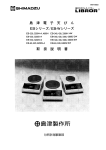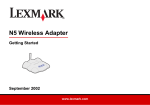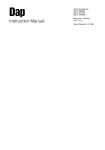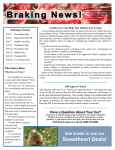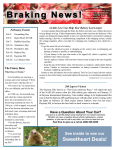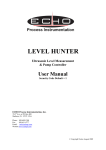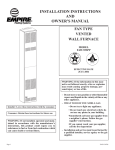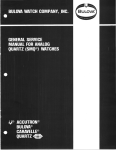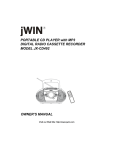Download Jwin JXCD4300 CD Shelf System
Transcript
JX-CD 4300D MICRO COMPONENT SYSTEM INSTRUCTION MANUAL Web site: http://www.jwin com CAUTION RISK OF ELECTRIC SHOCK DO NOT OPEN CAUTION: TO PREVENT THE RISK OF ELECTRIC SHOCK, DO NOT REMOVE COVER (OR BACK). NO USER-SERVICEABLE PARTS INSIDE. REFER SERVICING TO QUALIFIED SERVICE PERSONNEL. This symbol indicates that there are important operating and maintenance instructions in the literature accompany-ing this unit. This symbol indicates that dangerous voltage constituting a risk of electric shock is present within this unit. WARNING: TO PREVENT FIRE OR SHOCK HAZARD, DO NOT EXPOSE THIS APPLIANCE TO RAIN OR MOISTURE. CAUTION - USE OF CONTROLS OR ADJUSTMENTS OR PERFORMANCE OF PROCEDURES OTHER THAN THOSE SPECIFIED IN THE OPERATING INSTRUCTIONS MAY RESULT IN HAZARDOUS RADIATION EXPOSURE. 1. CLASS 1 LASER PRODUCT 2. DANGER: Invisible laser radiation when open and interlock failed or defeated. Avoid direct exposure to beam. 3. CAUTION: Do not open the top cover. There are no user serviceable parts inside the Unit; leave all servicing to qualified service personnel. FCC INFORMATION This device complies with Part 15 of the FCC Rules. Operation is subject to the following two conditions. (1) This device may not cause harmful interference, and (2) this device must accept any interference received. including interferencde that may cause undesired operation. CAUTION: WHEN INSTALLING THE BATTERIES To prevent leakage from the batteries, which is corrosive and can cause personal injury and damage to the unit, observe the following precautions: 1. The batteries must be installed correctly, Match the polarities (+ and - signs) on the batteries to the polarities shown on the back of the unit. 2. Do not mix new batteries with old used batteries. 3. Only use batteries of the same type and brand. 1 4. If the unit will not be used for an extended period of time, remove the batteries and store them in a cool place. 5. Carefully follow the battery manufacturer's instructions for proper use and disposal. 6. DO NOT ALLOW YOUNG CHILDREN TO HANDLE BATTERIES. NOTE: When the batteries have become discharged, they must be disposed of in a safe manner that complies with all applicable laws. IMPORTANT SAFETY INSTRUCTIONS 1. Read Instructions - All the safety and operating instructions should be road before the product is operated 2. Retain Instructions - The safety and operating Instructions should be retained for future reference. 3. Heed Warnings - All warnings on the product and in the operating instructions should be adhered to. 4. Follow Instructions - All operating and use instructions should be followed. 5. Cleaning - Unplug this product from the wall outlet before cleaning. Do not use liquid cleaners or aerosol cleaners. Use a damp cloth for cleaning. 6. Attachments - Do not use attachments not recommended by the product manufacturer as they may cause hazards. 7. Water and Moisture - Do not use this product near water - for example, near a bath tub, wash bowl, kitchen sink, or laundry tub; in a wet basement; or near a swimming pool; and the like. 8. Accessories - Do not place this product on an unstable cart, stand, tripod, bracket, or table. The product may fall, causing serious injury to a child or adult, and serious damage to the product. Use only with a cart, stand, tripod, bracket or table recommended by the manufacturer, or soid with the product. Any mounting of the product should follow the manufacturer's instructions, and should use a mounting accessory recommended by the manufacturer. A product and cart combination should be moved with care. Quick stops, excessive force, and uneven surfaces may cause the product and cart combination to overturn(Figure 131.2) 9. Ventilation - Slots and openings in the cabinet are provided for ventilation and to ensure reliable operation of the product and to protect it from overheating, and these openings must not be blocked or covered. The openings should never be blocked by Figure 131.2 placing the product on a bed, sofa, rug, or other similar surface. This product should not be placed in a built-in installation such as a bookcase or rack unless proper ventilation is provided or the manufacturer's instructions have been adhered to. 10. Power Sources - This product should be operated only from the type of power source indicated on the marking label. If you are not sure of the type of power supply to your home, consult your product dealer or local power company. For products intended to operate from battery power, or other sources, refer to the operating instructions. 11. Grounding or Polarization - This product may be equipped with a polarized alternating-current lone plug (a plug having one blade wider than the other). This plug will fir into the power outlet only one way. This is a safety feature. If you are unable to insert the plug fully into the outlet, try reversing the plug. If the plug should still fail to fit, contact your electrician to replace your obsolete outlet. Do not defeat the safety purpose of the polarized plug. 12. Power-Cord Protection - Power-supply cords should be routed so that they are not likely to be walked on or pinched by items placed upon or against them, playing particular attention to cords at plugs, convenience receptacles, and the point where they exit from the product. 2 13. Outdoor Antenna Grounding - If an outside antenna or cable system is connected to the product, be sure the antenna or cable system is grounded so as to provide some protection against voltage surges and built-up static charges. Article 810 of the National Electrical Code, ANSI/NFPA 70, provides information with regard to proper grounding of the mast and supporting structure, grounding of the lead-in wire to an antenna discharge unit, size of grounding conductors, location of antenna-discharge unit, connection to grounding electrodes, and requirements for the grounding electrode.(Figure 131.1) 14. Lightning - For added protection for this product during a lightning storm, or when it is left unattended Figure 131.1 and unused for long periods of time, unplug it from the wall outlet and disconnect the antenna or cable system. This will prevent damage to the product due to lightning and power-line surges. 15. Power Lines - An outside antenna system should not be located in the vicinity of overhead power lines or other electric light or power circuits, or where it can fall into such power lines or circuits. When installing an outside antenna system, extreme care should be taken to keep from touching such power lines or circuits as contact with them might be fatal. 16. Overloading - Do not overload wall outlets, extension cords or integral convenience receptacles as this can result in a risk of fire or electric shook. 17. Object and Liquid Entry - Never push objects of any kind into this product though openings as they may touch dangerous voltage points or short-out parts that could result in a fire or electric shock, Never spill liquid of any kind on the product. 18. Servicing - Do not attempt to service this product yourself as opening or removing covers may expose you to dangerous voltage or other hazards. Refer all servicing to qualified service personnel. 19. Damage Requiring Service - Unplug this product from the wall outlet and refer servicing to qualified service personnel under the following conditions: a) when the power-supply cord or plug is damaged, b) If liquid has been spilled, or objets to have fallen into the product, c) If the product has been exposed to rain or water, d) If the product does not operate normally by following the operating instructions. Adjust only those controls that are covered by the operating instructions as an improper adjustment of other controls may result in damage and will often require extensive work by a qualified technician to restore the product its normal operation. e) If the product has been dropped or damaged in any way, and f) when the product exhibits a distinct change in performance-this indicates a need for service. 20. Replacement Parts - When replacement parts are required, be sure the service technician has used replacement parts specified by the manufacturer or have the same characteristic as the original part. Unauthorized substitutions may result in fire, electric shook, or other hazards. 21. Safety Check - Upon completion of any service or repairs to this product, ask the service technician to perform safety checks to determine that the product is in proper operating condition. 22. Heat - The product should be situated away from heat sources such as radiators, heat registers, stoves, or other products (including amplifiers) that produce heat. FIGURE 1 EXAMPLE OF ANTENNA GROUNDING AS PER NATIONAL ELECTRICAL CODE ANTENNA LEAD IN WERE GROUND CLAMP ANTENNA DISCHARGE UNIT (NEC SECTION 810-20) ELECTRONIC SERVICE EQUIPMENT GROUNDING CONDUCTORS (NEC SECTION 810-21) GROUND CLAMPS POWER SERVICE GROUNDING ELECTRODE SYSTEM (NEC ART 250. PART H) 3 7 8 9 10 6 4 3 11 5 2 13 1 12 14 FM MODE /BEAT CANCEL 20 18 19 16 17 15 22 MONO 1 ST 2 21 23 24 25 28 27 26 25 Fig.1 VOLTAGE 110 VOLTAGE 220 240 120 220 ~ ~ SELECTOR ~ ~ 120 110 240 SELECTOR (For dual voltage model only!) Fig.2 4 Fig. 3a Fig. 3b Fig. 3c Fig.4 5 Fig.5 Fig.7 Fig.6 Fig.8 Fig.9 6 ENGLISH PRECAUTIONS The apparatus shall not be exposed to dripping or splashing. Do not use where there are extremes of temperature (below 5 C or exceeding 35 C). Because of the CD player's extremely low noise and wide dynamic range, there might be a tendency to set the volume on the amplifier unnecessarily high. Doing so may produce an excessively large output from the amplifier which could damage your speakers. Sudden changes in the ambient temperature may cause condensation to from on the optical lens inside the unit. If this happens, take out the disc, leave the unit for about 1 hour, and then proceed to operate. Do not install this equipment in a confined space, such as a book case or built in cabinet. The rating label is located on the back of the unit. 7 SPEAKERS Speakers connections (Fig. 3a) To detach the speaker enclosures (Fig. 3b) To attach the speaker enclosures (Fig. 3c) POWER SUPPLY AC POWER Before use, be sure the corresponds with you local voltage. Connect one end of the mains lead to the AC INPUT socket and the other end to an AC outlet. Note: The installed batteries are automatically disconnected when the mains lead is connected to the unit. The FUNCTION switch is mounted on the secondary side. The unit is not disconnected from mains, even switched off. CONTROLS (Fig. 1) 1. Function switch (FUNCTION) 2. Repeat button (REPEAT) 3. Volume control (VOLUME) 4. Skip/Search buttons ( , 5. Stop button ( ) 6. Bass expander button (DBBS) 7. CD track number display (TRACK NO.) 8. Indicator (STEREO) 9. CD compartment 10. Tuning control (TUNING) 11. Memory button (MEMORY) 12. Radio band switch (BAND) 13. Play/ Pause button ( ) 14. Cassette holder 15. Pause button (PAUSE) 16. Stop/ Eject button (STOP/EJECT) 17. Fast forward button (FFWD) 18. Rewind button (REW) 19. Play button (PLAY) 20. Record button (REC) 21. Telescopic aerial 22. FM mode/ Beat cancel switch (FM MODE/BEAT CANCEL) 23. Headphones socket (PHONES) 24. Speaker terminals (SPEAKERS) 25. Speaker release levers 26. Voltage selector (Option) 27. AC input socket (AC INPUT) 28. Battery compartment lid ) BATTERY POWER Installing batteries Install eight "R20/D" batteries (not supplied) as shown in Fig. 4. Cautions on batteries To prevent battery electrolyte leakage, which may result in injury and damage to the unit or other objects, observe the following precautions: 1. All batteries must be installed with the proper polarity (see diagram on the rear of the unit). 2. Do not mix new with old or used batteries. 3. Only use batteries of the same type and brand. 4. Remove the batteries when they are not to be used for a long period time. 5. Wh en th e b a t ter ies hav e bec ome discharged, they must be disposed of in a safe manner which complies with all applicable laws. GENERAL OPERATION CD PLAY Adjusting the volume Turn the VOLUME control. Use compact discs bearing the symbol shown in Fig. 5 In addition to conventional 12 cm CDs, this system can be used to play 8 cm CDs without an adapter. Bass expander button Press the DBBS button to ON to enhance the bass sound. Headphones Connect stereo headphones (not supplied) to the PHONES socket for monitoring or for private listening. The speakers are automatically disconnected when headphones are connected. 1. Set the FUNCTION switch to CD. 2. Press the CD compartment lid (CD OPEN/ CLOSE portion) to open it. 3. Place the disc with the label facing up on the turntable (Fig. 6). (Place only one disc at a time.) 4. Press the CD compartment lid (CD OPEN/ CLOSE portion) to close it. The total number of tracks on the disc appears on the TRACK NO. display. 5. Press the button. - To start play from the desired track, select the track by using the or buttons, then press the button. Note: If a disc is loaded upside down, or if no disc is loaded, 00 appears and the CD player will not operare. 6. Press the button to end disc play. When the last track has been played, the player stops automatically. 7. To turn the CD Player off, set the function switch to TAPE/OFF. Note: - Do not open the CD compartment during CD play. Always press the button and wait for the disc to top rotating betore opening the CD compartment. - This unit can play back the CD-R/RW as well. however, some CD-R/RWS can not be played back depending on the recording conditions. 8 Notes on handling compact discs - Do not expose the disc to direct sunlight, high humidity or high temperatures for extended periods of time. Discs should be returned to their cases after use. Do not apply paper or write anything on the disc surface. Handle the disc by its edge. Do not touch the playing surface (glossy side). Fingerprints and dust should be carefully wiped off the playing surface of the disc with a soft cloth. Wipe in a straight motion from the centre to the outside of the disc. Never use chemicals such as record cleaning sprays, antistatic sprays or fluids, benzene or thinner to clean compact dises. Temporarily stopping play Press the button. The CD PLAY indicator blinks.To resume play, press the button again. Skip play To skip to track 6 while track 3 is playing,press the button repeatedly until 6 appears on the display. To skip back to track 3 while track 6 is playing, press the button repeatedly until 3 appears. Search(forward/reverse) If the or button is pressed during play, the player will search at high speed in the forward or reverse direction while the button is being pressed. When the button is released normal play will continue. Repeat play Press the REPEAT button before or during play. Each time the button is pressed,the repeat mode changes. 9 PROGRAMMED PLAY Up to 20 tracks on a disc can be programmed for play in any order. - To begin the programming procedure, select CD function first. - The same track can be programmed more than once. - Load a disc that you want to programme before starting programmed play. 1. Press the button if necessary. 2. Press the MEMORY button 3. Select a track by using the and buttons. 4. Press the MEMORY button. 5. Repeat steps 3 - 4 to programme additional tracks. 6. Press the button to start play. When all programmed tracks have been played, the player stops automatically. The programme contents are retained in memory. - To cancel programmed play, press the button twice. Checking the programme Press the MEMORY button twice in the stop mode, the programmed tracks sequentially appear on the display. Changing the programme To add a new selection to a programme: 1. In the stop mode, press the MEMORY button. 2. Select the track number as explained above. 3. Press the MEMORY button. WHAT TO DO IF... If an abnormal display indication or an operating problem occurs, dcisconnect the mains lead and remove all batteries. Wait at least 5 seconds, then reconnect the mains lead and reinstall the batteries. Resume the operation. LISTENING TO TAPES LISTENING TO THE RADIO 1. Set the FUNCTION switch to TAPE. 2. Press the STOP/EJECT button. The cassette holder opens. 3. Load the cassette into the cassette holder (Fig.7). After loading the cassette, press the cassette holder back into position. 4. Press the PLAY button to begin playback. 5. Press the STOP/EJECT button to stop playback at any time. Press it again to remove the cassette. 1. Set the FUNCTION switch to RADIO. 2. Set the BAND switch to FM or AM as desired. 3. Tune in a desired station by turning the TUNING control. 4. To turn the radio off, set the FUNCTION switch to TAPE/OFF. Note: - Use the normal tape (TYPE 1). - Endless tapes cannot be used. - Do not use C- 100 (or longer) tapes. They may jam in the mechanism. Pause Press the PAUSE button to temporarily stop playback or recording. Press it again to resume operation. To receive FM stereo broadcasts Set the FM MODE switch to ST. - If the signal from an FM stereo station is weak and reception is poor, set the FM MODE switch to MONO. The reception may be improved, but the sound will be monaural. To improve reception FM: Pull out the telescopic aerial and adjust its position. AM: Rotate the unit. Fast forward and rewind Press the FFWD or REW button. When the desired location has been reached, press the STOP/EJECT button. 10 RECORDING MAINTENANCE Recording copyright material without permission of the copyright owners is usually an infringement. If you wish to record copyright material, permission from the copyright owner is necessary. jWIN does not approve of, and cannot be held responsible for, any unlawful use of this machine. Cleaning the tape heads To ensure continued high performance, use a cleaning tape (available f rom your local audio dealer) to clean the head block of the deck after about every 10 hours of use Re cording com pact discs 1. Load a blank cassette. 2. Select CD function. 3. Load the disc to be recorded. Select the track number if required. For programmed recording, programme the material in advance (as described under PROGRAMMED PLAY ). Press CD PLAY button. 4. Press the REC button. The PLAY button is engaged simultaneously and CD recording starts. 5. Press the STOP/EJECT button to stop recording. Recording from the radio 1. Load a blank cassette. 2. Tune in the radio station to be recorded. 3. Press the REC button to start recording. 4. Press the STOP/EJECT button to stop recording. When beat is heard Beat (a high pitched noise) may sometimes be heard during the recording of radio broadcasts.If this occurs, set the BEAT CANCEL switch to the position that reduces the level of the beat noise. Safeguards against accidental erasure To protect side A, break out tab (1).To protect side B, break out tab (2) (Fig.8). To erase or record a protected cassette, cover the tab openings with adhesive tape (3). Note: The REC button cannot be depressed when using a protected cassette. 11 Cleaning the unit Clean the outside of the unit with a clean soft cloth, mois tened with lukewarm water. Do not use benzene, thinner, or alcohol since they will mar the finish of the surfaces. Cleaning the CD player lens The lens should never be touched. If dust is on the lens, blow it off using a camera lens blower. (Fig. 9). (Consult your dealer.) 12 5 6 Esta unidad tambien puede reproducir el CD-R/ RW. sin embargo. y dependiendo de las condiciones de grabacion, algunos CD-R/RW no pueden reproducirse. 13 20 14 7 15 9 8 16 SPECIFICATIONS CD Player Channels: 2-channel stereo Sampling frequency: 44.1 kHz Pick-up: Semiconductor laser Laser output: 0.6 mW (Continuous wave max.) Wave length: 790 nm Wow/Flutter: Below measurable limits Radio Reception frequency: FM 88 - 108 MHz AM 530 - 1710 KHz General Output power: 4W x 2 (RMS) Speakers: 12 cm x 2 (4 ohms) Terminal: PHONES: 32 ohms Power source: AC: 110/220V 60/50Hz DC: 12V (UM -1X8) batteries Dimensions: 555(W) x 250(H) x 230 (D) mm Weight: Approx. 5.1 kg (without batteries) Specifications subject to change without notice. Cassette deck Track system: 4-track, 2 - channel stereo Erasing system: Magnet erase Tape speed: 4.75 cm/sec. Frequency response: 80 ~ 12,000 Hz Fast forward/rewind time: Approx. 110 sec. (C-60) For future reterence, fill in the space provided for model number and serial number. Model No.: Serial No.: 17


















